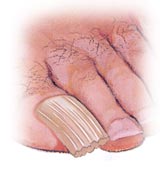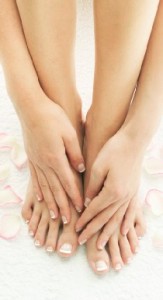Step1 Gather Materials
Choose a comfortable area of your home that's near a faucet and gather the following items for easy access:
• Nail polish remover
• A large bowl or foot bath filled with water and bubble bath
• Cuticle oil
• Exfoliating foot scrub
• A bath towel
• A hand towel
• A foot callus file
• Nail clipper
• A fine grit nail file
• Foot lotion
• Cotton pads
• Base coat
• Your chosen nail polish color
• Top coat
• Toe separators
Optional:
• Cuticle treatment and stain remover
• Epsom salt
• Peppermint oil
• Clay foot mask
• A terry cloth towel
• Short, stiff paint brush
Step 2 Remove Polish

If you have any leftover polish on your feet, use mild acetone polish remover and a cotton pad to remove it. "Acetone remover is not damaging to nails [and] cuts through pigment faster than non-acetone remover, which can leave traces of pigment on nails that can lead to discoloration over time," says Valinoti.
Tip: Have dark polish stains? ", gently removes dead skin tissue from cuticles, making them soft and pliable. It also removes dark or light stains from nails and is sooo great for pedicures," says Hipp.
Step 3 Soak
"Make an at-home pedicure more relaxing by soaking your feet in a large bowl with bubble bath (we like Davies Gate Nutrient Rich Foaming Bath, $20) for 10 or so minutes before you get working," says Dihn. "Read a magazine or listen to music and just relax. Then get to work." Before you fill your foot bath or large bowl with water, make sure to put a bath towel underneath it to catch any spills or "debris" from your pedicure.
Tip: Add epsom salt (go plain or use Dermalogica Hydro Active Mineral Salts, to your foot bath to soothe tired feet and help reduce any swelling at the end of a long day.
Step 4 Treat Cuticles
Pull one foot from the foot bath and put drop cuticle oil (we like Lippmann Collection Cuticle Oil, $18) on each nail. Massage it in and glide a wooden cuticle stick around the nail to push back any dead skin that might be clinging to the nail plate. Switch feet, submerging your first foot back into the water, and do the same on your other foot.
Step 5Exfoliate

Pull your first foot out of the foot bath and wet your leg up to your knee. Using a granular foot scrub (like CND Creative Spa Sea Salt Glow, $25.95, or Essiespa Exfoliating Scrub, $18), gently massage along the bottoms of your feet up to the knee. "Concentrate pressure where there is a callus or dry skin build-up," says nail pro Valinoti. Rinse thoroughly and do the same with your other leg.
Tip: If you desire, dampen a clean towel and warm in the microwave for 15 to 20 seconds, then use it to help rinse your feet.
Step 6 Smooth Skin
Gently glide a callus smoother (try a double-sided one like Titania Double Sided Foot Callus File, $5.09, which has pumice on one side and a file on the other) over calluses to smooth (not remove) rough, dry areas on the bottoms and sides of feet and toes.
Tip: "If you don't have a foot file handy, use a very coarse nail file to smooth rough skin patches," says Dihn. Put feet back in foot bath to rinse.
Step 7 Hydrate
Remove one foot from foot bath and pat dry with a hand towel. For a relaxing, cooling sensation that will soothe feet and make them tingle for at least an hour, combine a few drops of peppermint oil (try Aveda Blue Oil Balancing Concentrate, with a foot lotion or rich cream (Hipp recommends Sally Hansen's JUST FEET Cracked Heel Repair Creme, and massage into legs and feet. (Or for an all-in-one option, try Miss Oops Pedicure In A Bottle
Tip: For more intense moisturization, do a mask first. After removing your first foot from the foot bath, spread an even coat of clay foot mask (try CND Creative Nail Design Raw Earth Foot Mask, on your foot and ankle. Wrap with plastic wrap, then a terry cloth towel. Repeat on your other foot. Wait three to five minutes, rinse thoroughly. Then massage feet with lotion as suggested above.
Step 8 Prepare Nails
Use a disinfected, curved toenail trimmer (try Revlon Toenail Clip, $3) to cut the corner of each nail at a 45-degree angle to help prevent ingrown nails. Next cut any nails that are too long straight across. Finish by shaping nails with a fine (around 240 grit) flat file (try Trim Salon Boards, $2) or glass file to smooth uneven edges and corners. Double-check for any remaining cuticle that might be stuck to the nail and file it smooth. Swipe all nails with polish remover to get rid of residual oils and extend the life of your polish. Weave toe separators between toes.
Step 9 apply polish
Apply one thin layer of base coat, followed by two thin coats of nail enamel in your chosen color and one final thin layer of shiny top coat. Let each coat dry for about two minutes between applications. Don't have a steady hand? "Fix any polish mistakes by dipping a short, stiff paint brush in nail polish remover. Just glide it along the edges of your nails to clean up the paint," says Dihn. (Wait until nails are fully dry before you clean up your workspace, and wait at least two hours before putting on close-toed shoes).
Tip: Avoid air bubbles in your painted nails by storing polish in a cool, dry place and rolling bottles between palms, not shaking them, before applying.
step 10 Make It Last
To make your pedicure last longer, always use a base coat and top coat, and apply a fresh coat of clear polish every three days. (Do this right after hitting the beach to make polish dulled by sand look fresh again.) Keep polish and cuticles well oiled with a purse-sized cuticle oil like Orly Cuticle Care Complex, , which comes with a convenient dropper applicator. "It's easy to apply onto cuticles even on the go and also prevents bacteria, dirt, etc., from going back into the formula (which brush applicators tend to do)," says Hipp.
Tip: To keep cuticles and nails soft and smooth, Valinoti says, "Shampoo and condition [them] daily!"



 How to strenghten nails:
How to strenghten nails:










































